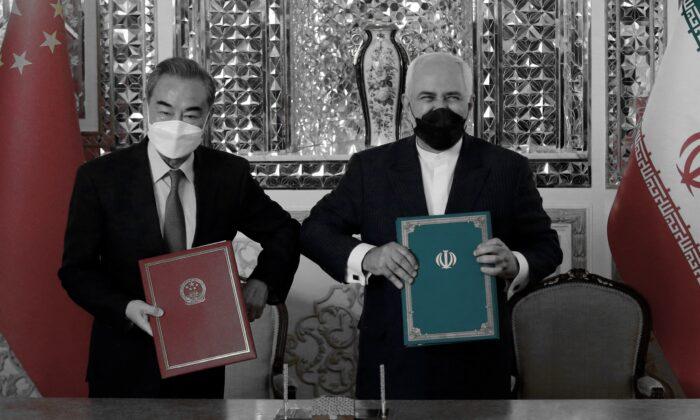China and Iran signed a 25-year-long “strategic partnership” agreement on March 27, by which both states would cooperate to challenge the United States, such as against U.S. sanctions on selling oil from Tehran to Beijing.
Chinese state-run Beijing News reported on the agreement and
said on March 28, “China and Iran’s exterior trouble-makers are the same, which are the western big countries that are led by the United States.”
The report then praised the China–Iran cooperation and criticized the United States: “The world has experienced major changes, but the U.S. and its western allies are still living in the old dreams.”
The U.S. government
imposed sanctions on Iran’s oil sector in October 2020 for supporting the Quds Force, a foreign paramilitary and espionage force in the region. China, however, continues to buy oil from Iran. Chinese ambassador to Iran Chang Hua
said on Feb. 5 that China was the only country that buys oil from the Islamic Republic, and pledged that Beijing wouldn’t change the policy in the future.
On March 27, Iranian President Hassan Rouhani
told Chinese Foreign Affairs Minister Wang Yi in Tehran that the Iran–China cooperation would support Iran against the United States’ unilateral sanctions.
The strategic partnership deal covers politics, economy, and security, according to Chinese state-run
CGTV. Iranian Tasnim
reported that the agreement also included judiciary, defense, human and cultural, and regional and international issues. A leaked draft that
circulated last July showed that China would invest in Iran’s telecommunication, nuclear energy, ports, and railroads and would receive a stable oil and gas supplement from Iran.
Oil Pipeline
Rouhani said in Tehran on March 25 that the country has started to build the Goureh-Jask crude oil pipeline, which starts from the southwestern province of Bushehr and ends at Jask Port in southeast Iran.
“The Goureh-Jask crude oil pipeline includes 1,000 kilometers (621 miles) of pipe laying so that a large part of our oil exports will be transferred from the Persian Gulf to the Sea of Oman,” Rouhani said.
Tasmin
reported that the total budget of the pipeline project is $2 billion. On June 25, 2020, the day Iran started the project, Iranian state television
reported that the project’s envisaged storage capacity is 10 million barrels of crude.
It’s unclear which party is investing in the oil pipeline. Rouhani
said on Iranian state television last June that it’s a foreign company, without giving any details about the company.
Chang said clearly that China is the only country that buys Iranian oil, and China is against the U.S. sanctions on Iran.
Iran–China Relations
The Iranian fiscal year starts in March. The Islamic Republic’s customs office
announced on March 28 that China had become its top trading partner for both import and export.
The office said Iran had imported $9.76 billion valued goods from China in the last fiscal year, which was 25.3 percent of total imports. At the same time, Iran had exported $8.95 billion in non-oil goods to China, which is equal to 26 percent of the total non-oil export.
The office didn’t mention the trade details about oil.
On March 28, Iranian Parliament Speaker Mohammad Baqer Qalibaf
posted on Twitter that the 25-year cooperation plan with China is good for the regime, and parliament needs to resolve some issues before approving it.
Opposition in Iran
In recent days, Iranian people
started a campaign on Twitter to oppose it, called “No2ChinaIRAccord.”
A picture with the note “China, get out of Iran” is broadly circulated among Iranians.
“The Islamic Republic has transferred control of many cities and the Persian Gulf to the Chinese regime for its own survival only, which is more shameful than selling its territory,” Twitter user Kayvan_E. Arani
posted on March 26. “The Chinese regime must leave Iran.”
The Iran–China strategic partnership agreement is part of China’s Belt and Road Initiative (BRI), according to Chinese state-run CGTV.
BRI, also known as
One Belt, One Road, is a massive global investment strategy launched by the CCP in 2013 aimed at bolstering its economic and political influence across Asia, Europe, Africa, and South America. The project involves investments in infrastructure and natural resource projects in countries. It has been criticized by the United States and other countries as an example of “
debt trap” diplomacy, which saddles developing countries with unsustainable debt burdens while allowing the regime to export its technology and governance abroad.





